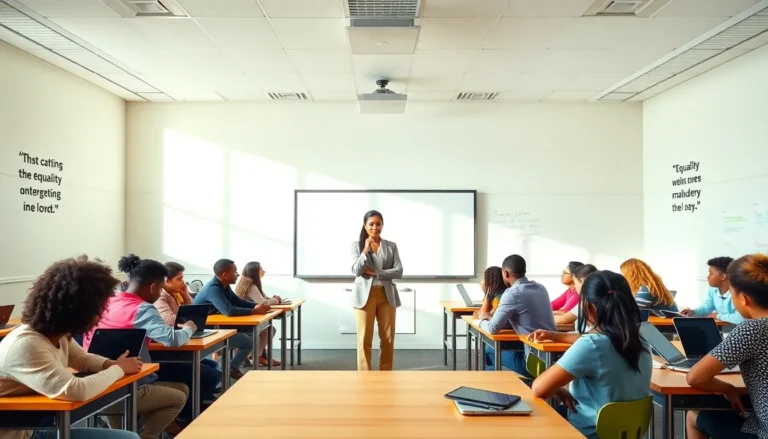As schools around the globe reopen their doors, the landscape of education has transformed in ways no one could have predicted. Gone are the days of traditional classrooms filled with the sounds of chalk on blackboards and the occasional pencil drop. Welcome to the new era of post-pandemic schooling, where Zoom calls and social distancing have become part of the curriculum.
Parents, students, and teachers are all navigating this brave new world together, armed with laptops and an endless supply of snacks. It’s a wild ride filled with challenges, laughter, and the occasional “Can you hear me now?” echoing through the virtual halls. Join the conversation as we explore how education is adapting and evolving, ensuring that learning continues to thrive—one hilarious mishap at a time.
Table of Contents
ToggleOverview of Post Pandemic Schooling
Post pandemic schooling reflects a shift in educational practices driven by necessity. Blended learning environments combine in-person and online instruction. Students experience diverse learning formats, often selecting the method that best suits their needs. Classrooms now incorporate technology more than before, with digital resources enhancing traditional lessons.
Social distancing guidelines continue to shape classroom layouts. Desks remain spaced apart, minimizing close contact among students. Many schools have invested in better ventilation systems to create safer environments. Extracurricular activities adapt to these new realities, with some schools opting for virtual clubs and online competitions.
Educators face new challenges in maintaining engagement during remote and hybrid classes. Innovative teaching strategies emerge to foster participation. Teachers utilize interactive platforms and multimedia tools to keep students focused. Professional development opportunities grow for educators, emphasizing skills in digital instruction.
Parents play a central role in supporting their children’s education. Communication between households and schools increases to address academic progress and emotional well-being. Family involvement is crucial, with many parents taking more active roles in their children’s learning journeys.
Assessment methods undergo revisions, focusing on holistic evaluations rather than standardized testing alone. Schools explore alternative metrics to gauge student success. Early interventions often emphasize mental health, ensuring students receive necessary support.
Education systems evolve to adapt to the ongoing demands of post pandemic learning, striving to offer resilience in the face of uncertainty. The collective experience fosters collaboration among students, educators, and families, paving the way for a more flexible approach to education.
Changes in Educational Environments
Post-pandemic schooling has significantly transformed educational environments, emphasizing flexibility and adaptability.
Classroom Adaptations
Classrooms now feature reconfigured layouts to maintain distance between students. Schools often use smaller class sizes to facilitate effective learning while adhering to health guidelines. Enhanced cleaning protocols ensure a safe atmosphere, reinforcing student and staff safety. Educators commonly integrate technology, such as smartboards and tablets, to foster interactive lessons. Many institutions have also upgraded ventilation systems, creating healthier indoor air quality. This combination of measures leads to a more engaging and secure learning environment.
Remote Learning Innovations
Innovations in remote learning strategies have emerged as essential components of education. Schools frequently utilize various online platforms for live instruction and assignment submissions. Many teachers incorporate multimedia resources, such as videos and interactive software, to enhance student engagement. Assessment methods have shifted to include project-based evaluations rather than traditional tests, promoting skill development. Increased collaboration through group projects in virtual settings enriches student interactions. Overall, these innovations create a more inclusive and diverse educational experience.
Impact on Students
Post-pandemic schooling has profoundly influenced students in various aspects. The transition to new learning methods, coupled with unique challenges, has reshaped their educational experience.
Academic Performance
Engagement has become a critical focus for students since traditional methods shifted. Blended learning environments give students more flexibility, and many have adapted well to online coursework. Some learners thrive in virtual settings, impacting their overall academic performance positively. Others struggle, signaling an increasing need for targeted support. Assessment methods now emphasize holistic evaluations rather than solely relying on standardized testing. This approach enables educators to identify individual student needs and tailor strategies accordingly. Academic progress reports reflect these changes, showcasing a broader perspective on students’ abilities.
Social and Emotional Wellbeing
Social interactions play an essential role in students’ lives, and the pandemic disrupted established connections. Emotional wellness has gained significant attention as students navigate new social dynamics. Increased communication between parents and educators supports students’ emotional needs effectively. Skills such as resilience and adaptability are more prominent in discussions surrounding emotional health. Virtual clubs and online group activities encourage socialization in a modified format. Attention to mental health initiatives remains crucial as students readjust to in-person and hybrid learning. Programs focusing on social engagement help foster connections and support emotional wellbeing in challenging times.
Teacher Perspectives
Educators play a pivotal role in navigating the complexities of post-pandemic schooling. Their insights reveal the multifaceted challenges and successes experienced during this transformative time.
Challenges Faced
Disruption in traditional teaching methods emerged as a primary concern for teachers. Many struggled with the integration of technology into lessons while ensuring students remained engaged. Time constraints intensified workloads. Teachers often worked longer hours to adapt curriculum materials for online and hybrid formats. Lack of training on new digital tools left some teachers feeling unprepared for virtual instruction. The social-emotional needs of students added another layer of difficulty. Maintaining relationships remotely posed significant challenges, especially for younger students who thrive on personal interaction. Adapting to smaller class sizes altered classroom dynamics, creating a need for individualized attention.
Success Stories
Positive experiences also surfaced amid the challenges. Innovative teaching strategies flourished as educators embraced new methods of engagement. For example, many teachers successfully implemented project-based learning to promote collaboration among students. Using multimedia resources energized lessons and sparked creativity in students, resulting in enhanced participation. Flexible lesson plans allowed teachers to tailor instruction to meet diverse learning needs, improving student outcomes. Stronger relationships developed between teachers and families through increased communication. Many educators reported that feedback from parents fostered a support system essential for student wellness. Overall, these successes highlighted the resilience of teachers and their commitment to adapting to new educational landscapes.
Future of Education Post Pandemic
Education is evolving as schools adapt to a post-pandemic landscape. The future emphasizes flexibility and innovation.
Hybrid Learning Models
Hybrid learning models blend in-person and online instruction, allowing students to choose their preferred learning format. This approach caters to diverse needs and learning styles, enabling personalized education. Classrooms now utilize technology to enhance collaboration, fostering interactive experiences that engage students. Educators focus on creating dynamic environments where students can thrive, whether they’re in the classroom or participating remotely. Schools embrace strategies that encourage participation, ensuring that each student feels included regardless of their physical location.
Policy Changes
Policy changes support the shift towards more adaptable educational frameworks. Schools implement new guidelines for safety, emphasizing smaller class sizes and better ventilation in physical spaces. Flexibility in curriculum design allows educators to integrate varied instructional methods that meet the needs of all learners. Assessment practices evolve to focus on holistic evaluations, providing a more comprehensive understanding of student progress. Educators advocate for continuous training, ensuring teachers stay current with technological advancements. These policy updates prioritize student well-being, fostering environments that support not just academic growth but also emotional health.
Post-pandemic schooling represents a transformative period in education that prioritizes flexibility and innovation. As students and educators navigate this new landscape, the emphasis on blended learning and technology integration is reshaping the educational experience.
The focus on emotional wellness and holistic assessments ensures that individual needs are met while fostering a supportive environment.
As schools continue to adapt, the collaboration between families and educators will play a crucial role in nurturing student growth. This evolving approach not only prepares students for future challenges but also creates a more inclusive and engaging learning atmosphere.



